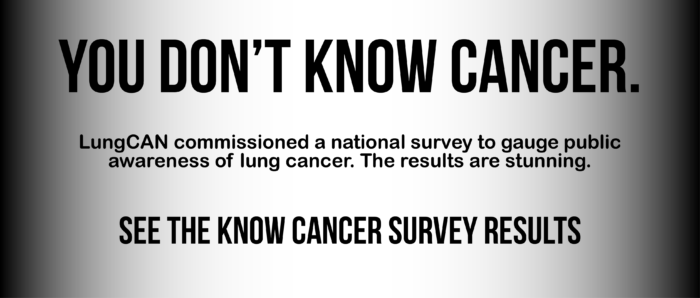2018 Know Cancer Survey Results

LungCAN commissioned an online survey of 2026 adults in the U.S. between Oct. 11–15, 2018, administered by High Point University’s Survey Research Center. Survey highlights are below.
Know Cancer Survey Highlights[1]
- Ninety-four percent of respondents were unaware that lung cancer is the number one cancer killer of women. Most respondents, 71 percent, incorrectly believed that breast cancer is the number one cancer killer of women. In fact, lung cancer kills nearly twice as many women as breast cancer. [2]
- Approximately 86 percent of respondents were unaware that lung cancer is the number one cancer killer of men. Sixty-two percent incorrectly believed prostate cancer is the number one cancer killer of men. In fact, lung cancer kills nearly three times as many men as prostate cancer.[3]
- Approximately 88 percent of respondents were unaware that radon is the number two cause of lung cancer. According to the National Cancer Institute, scientists estimate that 15,000 to 22,000 lung cancer deaths in the United States each year are related to radon.[4]
- Most respondents were aware of screening for people considered at risk for breast, colon and prostate cancers. However, nearly two-thirds of respondents, 64 percent, were unaware that screening protocols exist for people at risk for lung cancer. Seventy-two percent said there were aware that screening protocols exist for breast cancer; 58 percent for colon cancer; and 57 percent for prostate cancer.[5]
- In related responses, approximately 83 percent correctly said that mammogram is used for breast cancer screening. However, 60 percent, were unaware that lung cancer screening uses CT scan. [6]
- Eighty-seven percent of respondents were unaware that most lung cancer diagnoses are in people who are former smokers or never smoked. [7]
- Ninety-two percent of respondents were unaware that people who quit smoking as many as 15 years ago may still qualify for lung cancer screening.[8]
- Nearly half of respondents correctly said that screening could reduce the lung cancer mortality rate by 20 percent. [9]
- Most respondents, 61 percent, correctly stated that, of major cancers, breast cancer receives the most NCI research funding. [10]
- Prior to taking the survey, 15 percent of respondents said they knew “a lot” about lung cancer. Nearly half, 49 percent, said they knew “a little” about lung cancer. Thirty-five percent acknowledged they knew “not much at all” about lung cancer.
Conclusion: The public is woefully unaware about the number one cancer killer.
[1] Full text of survey questions and results may be accessed at High Point University Survey Research Center.
[2] “Estimated New Cancer Cases and Deaths for 2018,” SEER Cancer Statistics accessed 10/18/2018
[3] “Estimated New Cancer Cases and Deaths for 2018,” SEER Cancer Statistics accessed 10/18/2018
[4] “Radon and Cancer,” National Cancer Institute website accessed 10/18/2018
[5] “Lung Cancer: Screening,” U.S. Preventive Services Task Force accessed 10/18/2018
[6] “Lung Cancer: Screening,” U.S. Preventive Services Task Force accessed 10/18/2018
[7] “Out of the Shadows: Women and Lung Cancer,” Harvard Medical School & Brigham and Women’s Hospital, 4/22/2010
[8] “Lung Cancer: Screening,” U.S. Preventive Services Task Force accessed 10/18/2018
[9] “Reduced Lung-Cancer Mortality with Low-Dose Computed Tomographic Screening,” The New England Journal of Medicine, 8/4/2011
[10] “Funding by Research Areas,” National Cancer Institute accessed 10/18/2018
Radio Campaign Sponsored by

